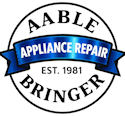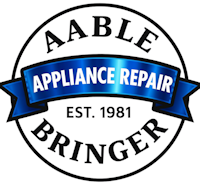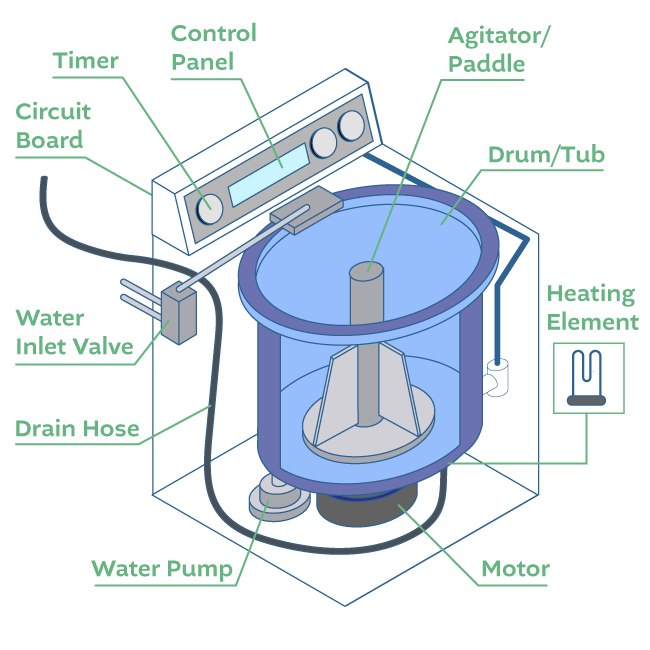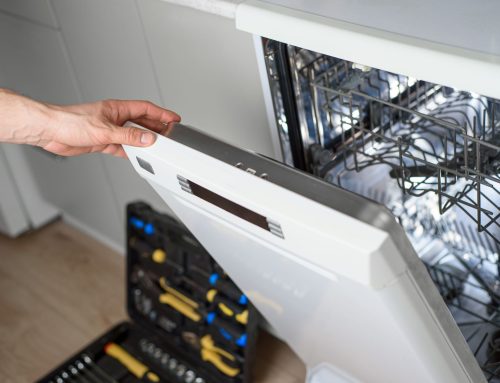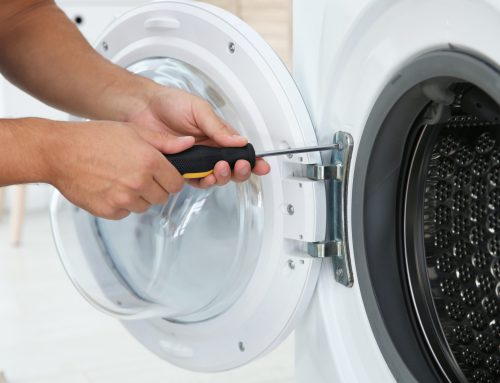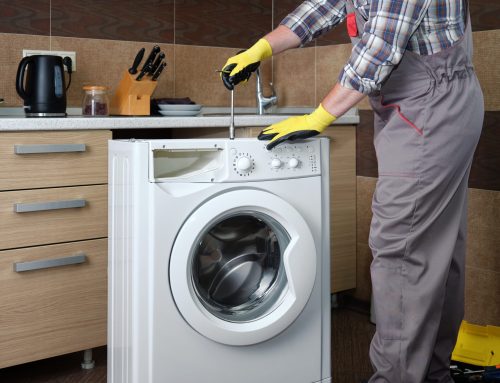When your laundry routine hits a snag, it can feel like a major setback in your busy life. To prevent laundry-day disasters and ensure your washer keeps running smoothly, it’s crucial to understand common washer issues and the action plan required to tackle them.
As you read this guide, you’ll be equipped with the knowledge to convey the issue to the repair experts. Get your washer back running to keep your clothes clean and your routine on track.
No need to stress – approaching washer repair in Louisville, KY is simpler than you may think!
Essential Components of a Washer and Their Functions
Understanding your washer’s key components can make troubleshooting and washer repairs much easier.
Here’s a breakdown of the essential parts that keep your washer running smoothly:
- Water Pump: Responsible for draining water out of the washer after the wash and rinse cycles. It’s essential for removing dirty water and preventing flooding.
- Drain Hose: Carries used water from the washer’s pump to your home’s drainage system. It needs to be properly positioned to avoid leaks and ensure effective draining.
- Water Inlet Valve: Controls the flow of water into the washer. It opens to allow water in and closes when the desired level is reached.
- Drum/Tub: Space where your clothes are washed. It spins during the wash and rinse cycles, agitating the laundry to ensure effective cleaning.
- Agitator/Paddle: Helps to move clothes around the drum during washing, enhancing the cleaning action by creating movement in the water. Found in top-loading washers.
- Motor: Powers the drum and agitator, driving the mechanical components that make washing and spinning possible.
- Circuit Board: Commands the control panel and wash cycles, as well as firing off the different electronic parts that are needed for your washer to do its job.
- Timer: Timers on washing machines can either be set manually or automatically, and will set the wash time for your laundry cycles.
- Control Panel: Allows you to set wash cycles, temperatures, and other settings. It’s the interface between you and the washer’s operation.
- Heating Element: When using cycles that will run either warm or hot water, this element heats up the water to the desired temperature.
5 Most Common Issues of Washers
Here are the five most common washer issues and how to identify them:
1. Washer Won’t Turn On
- Power Supply: If your washer doesn’t turn on, it could signal an issue with the power supply, such as a loose connection or a tripped circuit breaker.
- Door/Lid Switch: A washer that won’t start might indicate that the door or lid switch isn’t engaging properly, preventing the machine from operating.
- Control Panel: Unresponsive controls or error codes on the control panel could point to a faulty control system, requiring professional attention.
- Fuse or Circuit Breaker: A washer that won’t power up may be linked to a blown fuse or tripped circuit breaker, necessitating an inspection by a technician.
2. Washer Is Leaking Water
- Hoses: Water leakage might indicate damaged or loose inlet and drain hoses, especially where they connect to the washer or water supply.
- Door Seal/Gasket: If you notice water escaping during the wash cycle, it could be a sign of a worn or torn door seal or gasket.
- Drain Pump: Puddles around the washer or near the pump area might suggest a leak in the drain pump, possibly due to damage or loose connections.
- Overloading: Frequent water leaks could be a result of overloading the washer, which can strain the seals and hoses, leading to spills
3. Washer Is Not Draining Properly
- Drain Pump Filter: If your washer isn’t draining, a clogged filter filled with lint or debris could be the culprit, hindering proper water flow.
- Drain Hose: A washer that won’t drain might signal a kinked or clogged drain hose, blocking the water from exiting the machine.
- Pump: Poor drainage can indicate an obstructed or damaged drain pump, which may require professional repair or replacement.
- Water Level Switch: If the washer fails to drain, a malfunctioning water level switch might not be signaling the pump to activate, leading to drainage issues.
4. Washer Makes Unusual Noises
- Grinding or Thumping: Unusual grinding or thumping sounds may indicate an issue with the drum or agitator, possibly due to foreign objects trapped inside.
- Squealing: A squealing noise could suggest a worn-out belt or a motor issue, signaling that these components may need an inspection for wear or damage.
- Banging: If you hear banging noises, it could mean the washer is unbalanced. Ensuring the washer is level might resolve the issue.
- Clunking: Clunking sounds could point to loose parts or worn-out bearings, indicating the need for a professional to check for any damaged components.
5. Clothes Come Out Still Wet
- Spin Cycle Issues: If your clothes are still wet after a cycle, it might indicate a problem with the spin cycle, where the drum isn’t spinning fast enough to remove excess water.
- Overloading: Wet clothes could be a sign of overloading the washer, which can prevent the drum from spinning effectively. Reducing the load size may help.
- Drainage Problems: Improper drainage, possibly due to clogs in the drain hose or pump, can hinder the spin cycle’s effectiveness, leaving clothes wet.
- Faulty Motor: A malfunctioning motor could prevent the washer from spinning properly, leading to wet clothes that may require motor repair or replacement.
Maintenance Tips To Keep Your Washer Running Smoothly
Ensuring your washer operates efficiently is crucial for a smooth laundry routine.
Here’s why opting for professional washer repair in Louisville, KY and maintenance services is a wise decision:
- Extended Lifespan: Regular maintenance and timely repairs can address minor issues before they escalate into major problems. This proactive approach helps extend the lifespan of your washer, safeguarding your investment and delaying the need for a costly replacement.
- Improved Performance and Energy Efficiency: A well-maintained washer runs more effectively, cleaning your clothes thoroughly and using less energy. Proper servicing ensures that your washer operates at peak performance, which can lead to lower utility bills and fewer unexpected breakdowns.
- Enhanced Cleaning Results: Professional servicing includes checking and cleaning components like filters and pumps, which can improve the washer’s cleaning performance. This means your clothes come out cleaner and fresher, meeting your expectations every time.
- Reduced Risk of Water Damage: Timely repairs can prevent leaks and drainage issues that might cause water damage to your home. By addressing these problems early, you can avoid potential damage to flooring, walls, and other areas affected by water leakage.
- Fewer Disruptions and Noise: Regular maintenance helps minimize unexpected breakdowns and unusual noises, ensuring your washer operates smoothly and quietly. A well-maintained washer reduces disruptions in your laundry routine and contributes to a more peaceful home environment.
By investing in professional washer repair and maintenance, you ensure that your appliance remains efficient, effective, and reliable, all while avoiding unnecessary costs and inconveniences.
Cost of Washer Repair
Understanding the potential costs of washer repairs can help you budget and plan for repair. On average, a washer repair might cost around $200.
Here’s a breakdown:
- Service Call Fee: Typically, there is a service call fee ranging from $75 to $150. This fee covers the technician’s visit to diagnose the problem and provide an initial assessment.
- Average Repair Costs: The cost of repairs generally ranges from $100 to $300, depending on the complexity of the issue and the parts required. Simple fixes like replacing a door seal or unclogging a drain may be on the lower end, while more extensive repairs such as motor replacements can be more costly.
If your washer is frequently breaking down or repair costs are nearing the price of a new unit, it may be time for a replacement. Consider replacing your washer if it’s over 10-15 years old, struggles with performance, or causes high energy bills.
Additionally, if safety concerns or outdated technology are issues, investing in a new washer could be more cost-effective and ensure greater efficiency and safety in the long run.
Frequently Asked Questions
Get Back on Track with Professional Washer Repair Services
Don’t let washer problems put a damper on your laundry routine. Our skilled technicians Bringer Appliance Repair are here to handle everything from diagnosing and repairing common issues to providing maintenance that keeps your washer in top condition.
Regular washer repair and servicing not only extends the life of your appliance but also ensures optimal performance and prevents unexpected disruptions.
With our competitive rates and expert advice on washer repairs in Louisville, KY, you can trust us to help you make the best decision for your washer.
Schedule Your Repair Today! Keep your laundry running smoothly and efficiently.
